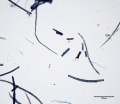Difference between revisions of "Soda process"
Jump to navigation
Jump to search
JMcGlinchey (talk | contribs) |
m (Text replace - "== Authority ==" to "== Sources Checked for Data in Record ==") |
||
| (4 intermediate revisions by one other user not shown) | |||
| Line 6: | Line 6: | ||
== Other Properties == | == Other Properties == | ||
| − | When stained with [[Graff | + | When stained with [[Graff "C" stain]], soda pulp can appear in a range of colors depending on the wood type and the amount of bleaching. Unbleached soda pulps will appear yellow or grey/green. With increased bleaching, pulps will appear lighter and tend more toward blue or purple when treated with stain. |
| − | == | + | ==Additional Images== |
| + | <gallery> | ||
| + | File:Sisal 40x.jpg|Soda pulped sisal fibers | ||
| + | File:Sisal 10x.jpg|Soda pulped sisal fibers | ||
| + | File:Esparto 40x serratedepi.jpg|Soda pulped esparto | ||
| + | </gallery> | ||
| + | |||
| + | == Sources Checked for Data in Record == | ||
* Christopher Biermann. ''Essentials of Pulping and Papermaking''. Academic Press, 1993. | * Christopher Biermann. ''Essentials of Pulping and Papermaking''. Academic Press, 1993. | ||
| + | |||
| + | * J. H. Graff "Color Atlas for Fiber Identification" The Institute of Paper Chemistry, Appleton, WI, 1940. | ||
*TAPPI Official Standard T401 om-08. ''Fiber analysis of paper and paperboard''. 2008. http://www.tappi.org/Downloads/Test-Methods/UNTITLED-0104T401pdf.aspx | *TAPPI Official Standard T401 om-08. ''Fiber analysis of paper and paperboard''. 2008. http://www.tappi.org/Downloads/Test-Methods/UNTITLED-0104T401pdf.aspx | ||
Latest revision as of 18:35, 1 May 2016
Description
A chemical method of producing paper pulp from wood and other plants using Sodium hydroxide. It was developed in 1851. This process is not in common use today, since it is not as effective as kraft pulping. However, the soda process is preferred for many types of non-wood paper pulps, such as Grass and Straw.
Synonyms and Related Terms
Soda pulp; hardwood bleached soda; hardwood soda
Other Properties
When stained with Graff "C" stain, soda pulp can appear in a range of colors depending on the wood type and the amount of bleaching. Unbleached soda pulps will appear yellow or grey/green. With increased bleaching, pulps will appear lighter and tend more toward blue or purple when treated with stain.
Additional Images
Sources Checked for Data in Record
- Christopher Biermann. Essentials of Pulping and Papermaking. Academic Press, 1993.
- J. H. Graff "Color Atlas for Fiber Identification" The Institute of Paper Chemistry, Appleton, WI, 1940.
- TAPPI Official Standard T401 om-08. Fiber analysis of paper and paperboard. 2008. http://www.tappi.org/Downloads/Test-Methods/UNTITLED-0104T401pdf.aspx


